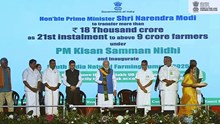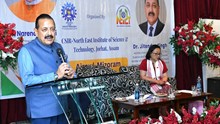
Quality seed production is one of the most critical components for ensuring the availability of quality seeds to farmers. Provision of quality seeds is an important step in enhancing the yield and production of pulses. To ensure the availability of location-specific high-yielding varieties and quality seeds, the Ministry of Agriculture and Farmers' Welfare, Government of India, implemented a project titled ‘Creation of Seed Hubs for Increasing Indigenous Production of Pulses in India’ during 2016-17. The project provided funds for seed multiplication and infrastructure development across the country. Under this project, a pulse seed hub was sanctioned to Krishi Vigyan Kendra (KVK), Nagaur-I.
The seed hub project was allocated to KVK, Nagaur-I, during 2016-17, with a one-time grant of Rs. 50 lakh in the first year for creating infrastructure such as a seed processing plant and storage facilities. Additionally, Rs. 1 crore was allocated as a revolving fund to meet the expenses for the production, procurement, and processing of seeds. At KVK, Nagaur-I, seed production was carried out on farmers' fields across different villages in the Nagaur district.
The main objective of this project was to ensure the supply of quality seeds and maintain sustainability and profitability for farmers locally by developing suitable infrastructure for seed quality enhancement, safe storage, and seed development.
Problems:
-
Lack of seed production knowledge and the limited availability of pulse seeds in the market, due to higher demand and minimal research activities, is a significant challenge faced by farmers.
-
The limited availability of widely adaptive varieties and the lack of diversity in local varieties is an issue that restricts pulse production.
-
Lack of quality and improved seed availability.
-
Limited availability of short-duration varieties and cultivars that can escape terminal drought.
-
Farmers do not benefit from the higher market prices of pulses. Market prices are largely controlled by local buyers, irrespective of the minimum support price (MSP), and procurement of pulses by government agencies is very limited. While the government has suggested procuring pulses at MSP, local market trends show that the rates offered by local dealers are much lower than the MSP.
-
Major constraints for pulse cultivation include the availability of desired quality and quantity of high-yielding varieties. Issues such as the lack of high-yielding varieties, low harvest index, high susceptibility to diseases and pests, flower drop, lack of short-duration varieties, intermediate growth habits, poor response to inputs, and instability in performance need immediate attention.
-
Lack of technical knowledge, such as improper sowing time, seed treatment, seed rate, defective sowing methods, insufficient irrigation, inadequate intercultural practices, and poor management of insect pests and diseases, are major constraints.
-
Poor knowledge among farmers regarding seed treatment, Rhizobium inoculation, and the adoption of proper cropping sequences/crop management practices to handle contingent situations.
-
Lack of seed production knowledge and limited availability of pulse seeds in the market, due to higher demand and minimal research activities, is an important challenge faced by farmers. The limited availability of widely adaptive varieties and diversity in local areas is an issue that restricts pulse production.
-
Due to slow initial growth, pulse crops face severe crop–weed competition at early growth stages. Effective chemical measures are limited due to the non-availability of post-emergence herbicides.
-
Lack of awareness and difficult access to warehouses, along with significant storage losses (20-30%) of pulses, are major market-related constraints.
-
Lack of guidance on proper certified seed production/variety identification, insect pest/disease identification and management, seed treatment/Rhizobium inoculation procedures, and current technological advancements. Additionally, there is poor or no knowledge about seed production and its protection for succeeding crops, as well as limited knowledge on nutrient use efficiency (NUE), integrated pest management (IPM), and the preparation of spray solutions.
Interventions by KVK:
-
Farmers were selected based on prior experience in pulse seed production, availability of adequate irrigation facilities, fertile soil, and good knowledge and skills for quality seed production. Their fields were equipped with appropriate infrastructure and assured irrigation.
-
Farmers were trained by KVK scientists in seed certification procedures, including rouging, isolation distance, field inspection, seed processing, and geo-tagging. KVK also conducted training in quality seed production.
-
Field visits were organized by the scientific staff of KVK, Nagaur-I, at farmer fields, with inspections by certification officers from the Rajasthan State Seeds & Organic Certification Agency (RSSOCA), Jodhpur, and consultants from Agriculture University, Jodhpur, during the cropping period. This aimed to create awareness about production technologies for pulses and quality seed production.
-
Foundation seeds of different varieties of mung beans were distributed by KVK to seed-producing farmers for certified seed production on their fields during the last four years (2020-2023) with the support of KVK, Nagaur-I.
-
Seed treatment with Carbendazim (50% WP) at 2.5 g/kg seed.
-
Line sowing in 30x10 cm rows and proper plant spacing.
-
Application of recommended nitrogen (N) at 20 kg/ha and phosphorus (P) at 40 kg/ha.
-
Application of zinc sulfate (33%) at 12.5 kg/ha, sulfur (80% WDG) at 2.5 kg/ha, and NPK (18:18:18) at 2.5 kg/ha for nutrient management.
-
Application of Fipronil (0.3% GR) at 12.5 kg/ha for termite management.
-
Application of Imazethapyr (10% SL) at 625 ml/ha, 15-18 days after sowing, for weed management.
-
Use of Imidacloprid (17.8% SL) at 250 ml/ha for the management of sucking pests.
Table-1: Details of seed production under seed hub as farmer participatory mode during 2020-2023
|
S. No. |
Year |
Season |
Crop |
Variety |
Category |
Production (qtls.) |
Income (Rs.) |
Horizontal spread in district (ha) |
|
1. |
2020-21 |
Kharif-2020 |
Mung bean |
IPM 2-14 |
CS |
352.90 |
49,40,600 |
9750 |
|
2. |
2021-22 |
Kharif-2021 |
Mung bean |
MH-421 |
CS |
50.00 |
7,50,000 |
955 |
|
3. |
2022-23 |
Kharif-2022 |
Mung bean |
MH-1142 |
CS |
225.36 |
33,80,400 |
4120 |
|
4. |
2023-24 |
Kharif-2023 |
Mung bean |
GM-7 |
CS |
139.88 |
20,98,200 |
2250 |
|
Total |
768.14 |
1,11,69,200 |
|
|||||
Table-2: Economics performance of technology in farmer participatory mode (FPM) and Farmer practices
|
Specific Technology |
Yield (q/ha) |
Gross cost (Rs/ha) |
Gross income (Rs./ha) |
Net income (Rs./ha) |
Additional income (Rs./ha) |
B:C ratio |
|
Technology (FPM) |
13.55 |
27500 |
136286 |
108785.9 |
56830.2 |
4.96 |
|
Farmer practices |
9.15 |
26350 |
78305.7 |
51955.7 |
- |
2.97 |
|
% Increase/different |
48.09 % |
1150 |
57980.2 |
56830.2 |
|
1.98 |
Technology (FPM): Selling rate Rs. 8558/- (MSP) + Rs. 1500/- (Subsidy) = Rs. 10058/ quintal
Farmer practices: Selling rate Rs. 8558/quintal (MSP)

Impact of quality pulses seed produced and supplied to farmers:
-
Crop failure risk minimization due to resistance/tolerance of improved varieties against biotic & abiotic stress.
-
Decrease in yield gap.
-
Upliftment in socio-economic status of farm families.
-
Quality seed availability builds faith & creates rapport of the KVK in the area.
Conclusion:
-
Establishment of such seed hub centre may play a major role in production of quality seed at local level which helps in the timely supply of seed to the farmers.
-
Required seed replacement rate (SRR) especially in pulses for recently released improved varieties can be meeting out only by production of sufficient quantity of quality seed at local level & KVK can play a major role in this.
-
To achieve the target of doubling farmer’s income, quality seed availability of pulses at local level at right time may play a vital role.
(Written by- H.R. Choudhary, Subject Matter Specialist (Agronomy), Gopichand Singh, Senior Scientist & Head, Bhawana Sharma, Subject Matter Specialist (Home Science), Budharam, Subject Matter Specialist (Animal husbandry) and Kalpana Choudhary, Subject Matter Specialist (Horticulture)- KVK, Athiyasan, Nagaur-I, Agriculture University, Jodhpur)
















